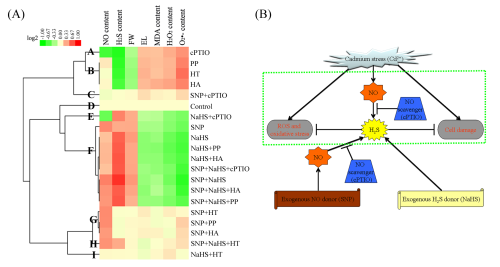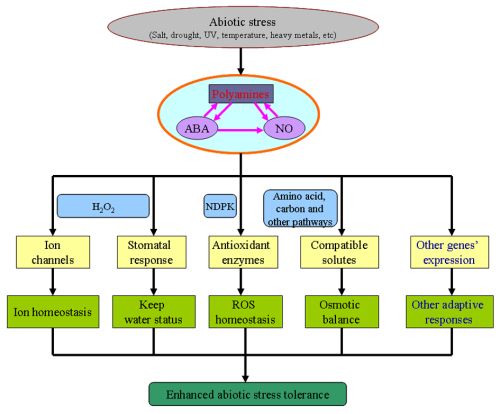武汉植物园破译一氧化氮和硫化氢诱导植物对镉离子胁迫抗性分
中国科学院武汉植物园植物水分胁迫生物学学科组施海涛博士在产祝龙研究员的指导下,以草坪草狗牙根为研究对象,研究发现,镉离子胁迫诱导了一氧化氮和硫化氢的大量产生。相关文章发表于《Plant Physiology and Biochemistry 》和《Journal of Integrative Plant biology 》杂志上。

一氧化氮和硫化氢供体和清除剂处理在狗牙根应答镉离子胁迫时对相关生理指标的调控(A)及一氧化氮和硫化氢多胺调控狗牙根应答镉离子胁迫的分子机理(B)

多胺调控植物非生物胁迫抗性的分子机理
干旱、盐和冷害等环境胁迫因子单独或者共同作用制约着农作物的生产,是农业生产减产的重要因素。
近年来,随着矿产资源的过度开采及农业中化肥的大量使用,土壤镉污染越来越严重,也成为影响我国持续农业和生态环境质量的一个重要因素。
植物由于自身不能移动,在长期的自然进化中形成一系列复杂的调控机制,来感受外部胁迫并传递信号,最终细胞和整在个植株水平形成应激性反应。在非生物胁迫的早期信号传导过程中,小分子物质包括活性氧(ROS)、一氧化氮(NO)、硫化氢(H2S)和多胺(Polyamine)等的交叉互作发挥着重要作用。
研究人员以草坪草狗牙根(Cynodon dactylon (L). Pers.)为研究对象,利用植物生理学和药理学等研究方法,对一氧化氮和硫化氢诱导植物对镉离子胁迫抗性的分子机理展开了一系列研究。
研究发现,镉离子胁迫诱导了一氧化氮和硫化氢的大量产生;一氧化氮和硫化氢的供体处理提高的一氧化氮和硫化氢含量可以显著提高狗牙根对对镉离子胁迫抗性,而一氧化氮和硫化氢的清除剂处理降低了的一氧化氮和硫化氢含量并降低了狗牙根对对镉离子胁迫抗性;同时一氧化氮和硫化氢均可以改变镉离子胁迫时的活性氧积累和抗氧化酶活性;进一步研究表明一氧化氮诱导产生的硫化氢是一氧化氮调控镉离子胁迫抗性必需的,从而解析了一氧化氮和硫化氢在植物镉离子胁迫早期反应中的上下游关系及生理机制。
同时,基于前期在多胺与植物胁迫抗性方面的研究结果(Journal of Experimental Botany, 2013, 64 (5): 1367-1379; Plant Signaling and Behavior, 2013, 8 (5): e24138; Journal of Proteome Research, 2013, 12 (11): 4951-4964),并结合国际上大量相关研究的文献资料,施海涛博士在产祝龙研究员的指导下,综述了非生物胁迫过程中,植物体内多胺合成和代谢途径基因表达及多胺含量的变化趋势;外源多胺处理和基因工程改变多胺合成及代谢相关基因的表达与植物非生物胁迫抗性的关系;并重点从多胺、脱落酸、活性氧及一氧化氮等小分子物质的交叉互作角度探讨了多胺调控植物非生物胁迫的分子机理。
以上研究获得中国科学院“百人计划”基金,中国科学院知识创新工程项目(No.54Y154761O01076和No.Y329631O0263)和国家自然科学基金(No.31200194 和No.31370302)的共同支持。
原文摘要:
Nitric oxide-activated hydrogen sulfide is essential for cadmium stress response in bermudagrass (Cynodon dactylon (L). Pers.)
Haitao Shi, Tiantian Ye, Zhulong Chan
Nitric oxide (NO) and hydrogen sulfide (H2S) are important gaseous molecules, serving as important secondary messengers in plant response to various biotic and abiotic stresses. However, the interaction between NO and H2S in plant stress response was largely unclear. In this study, endogenous NO and H2S were evidently induced by cadmium stress treatment in bermudagrass, and exogenous applications of NO donor (sodium nitroprusside, SNP) or H2S donor (sodium hydrosulfide, NaHS) conferred improved cadmium stress tolerance. Additionally, SNP and NaHS treatments alleviated cadmium stress-triggered plant growth inhibition, cell damage and reactive oxygen species (ROS) burst, partly via modulating enzymatic and non-enzymatic antioxidants. Moreover, SNP and NaHS treatments also induced the productions of both NO and H2S in the presence of Cd. Interestingly, combined treatments with inhibitors and scavengers of NO and H2S under cadmium stress condition showed that NO signal could be blocked by both NO and H2S inhibitors and scavengers, while H2S signal was specifically blocked by H2S inhibitors and scavengers, indicating that NO-activated H2S was essential for cadmium stress response. Taken together, we assigned the protective roles of endogenous and exogenous NO and H2S in bermudagrass response to cadmium stress, and speculated that NO-activated H2S might be essential for cadmium stress response in bermudagrass.
Improvement of plant abiotic stress tolerance through modulation of the polyamine pathway
Haitao Shi, Zhulong Chan
Polyamines [mainly putrescine (Put), spermidine (Spd) and spermine (Spm)] have been widely found in a range of physiological processes and in almost all diverse environmental stresses. In various plant species, abiotic stresses modulated the accumulation of polyamines and related gene expression. Studies using loss-of-function mutants and transgenic overexpression plants modulating polyamine metabolic pathways confirmed protective roles of polyamines during plant abiotic stress responses, and indicated the possibility to improve plant tolerance through genetic manipulation of the polyamine pathway. Additionally, putative mechanisms of polyamines involved in plant abiotic stress tolerance were thoroughly discussed and cross-talks among polyamine, abscisic acid (ABA) and nitric oxide (NO) in plant responses to abiotic stress were emphasized. Special attention was paid to the interaction between polyamine and reactive oxygen species (ROS), ion channels, amino acid and carbon metabolism, and other adaptive responses. Further studies are needed to elucidate the polyamine signaling pathway, especially polyamine regulated downstream targets and the connections between polyamines and other stress responsive molecules.

